Broad money growth accelerated during 2006-07, and remained above the indicative trajectory projected by the Reserve Bank at the beginning of the fiscal year. Bank credit continued to grow at a strong pace for the third successive year, albeit with some moderation. Deposits exhibited sharp growth and enabled financing of sustained high demand for credit. Banks’ investments in SLR securities increased during the year, but the pace of expansion did not keep pace with the expansion in their net demand and time liabilities (NDTL). As a result, banks’ SLR investments, as a proportion of their NDTL, declined further during 2006-07. The Reserve Bank continued to modulate market liquidity with the help of repo and reverse repos under the liquidity adjustment facility (LAF), issuance of securities, including dated securities, under the Market Stabilisation Scheme (MSS) and the cash reserve ratio (CRR). The task of liquidity management was complicated during 2006-07 due to large variations in market liquidity on account of variations in cash balances of the Governments and capital flows.
Monetary Survey
Broad money (M3) growth, year-on-year (y-o-y), accelerated to 20.8 percent as at end-March 2007 from 17.0 per cent a year ago. Expansion in the residency-based new monetary aggregate (NM3) – which does not directly reckon non-resident foreign currency deposits such as FCNR(B) – also accelerated from 18.1 per cent as at end-March 2006 to 20.4 per cent as at end-March 2007. Growth in liquidity aggregate, L1, at 20.0 per cent was also higher than that of 18.1 per cent a year ago. Growth in NM3 as at end-March 2007 was marginally lower than that in on M3. Growth in L1 was marginally lower than that in NM3 account of lower growth in postal deposits vis-à-vis bank deposits (Chart 14 and Table 22).
Taking into account, inter alia, high growth in monetary aggregates, sustained growth in credit offtake, trends in liquidity absorbed under LAF/MSS, challenges emanating from the effects of capital flows on liquidity, acceleration in inflation, growth in real GDP, expectations of the private corporate sector of higher increase in prices of both inputs and outputs, reports of growing strains on domestic capacity utilisation, global developments in monetary management and the paramount need to contain inflationary expectations, the Reserve Bank has announced an increase of 150 basis points in the cash reserve ratio (CRR) in phases from December 2006 (see also Chapter IV). The first round of increase in the CRR, announced on December 8, 2006, of 50 basis points – 25 basis points each – was effective in the fortnights 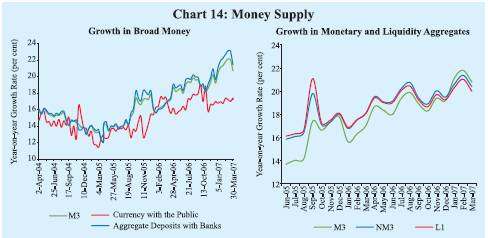
beginning December 23, 2006 and January 6, 2007. The second round of the increase, announced on February 13, 2007, also of 50 basis points – 25 basis points
Table 22: Monetary Indicators |
(Amount in Rupees crore) |
Item |
Outstanding as
on March 31, 2007 |
Variation |
2005-06 |
2006-07 |
Amount |
Per cent |
Amount |
Percent |
1 |
2 |
3 |
4 |
5 |
6 |
I. |
Reserve Money |
7,08,950 |
83,922 |
17.2 |
1,35,892 |
23.7 |
II. |
|
|
|
9,59,875 |
1,43,825 |
21.1 |
1,33,497 |
16.2 |
|
Narrow Money (M1) |
|
|
|
|
|
III. |
|
|
|
32,96,919 |
3,96,881 |
17.0 |
5,67,372 |
20.8 |
|
Broad Money (M3) |
|
|
|
|
|
|
a) |
Currency with the Public |
4,84,171 |
58,248 |
16.4 |
71,052 |
17.2 |
|
b) |
Aggregate Deposits |
28,05,261 |
3,38,081 |
17.1 |
4,95,704 |
21.5 |
|
|
i) |
Demand Deposits |
4,68,216 |
85,025 |
26.5 |
61,829 |
15.2 |
|
|
ii) |
Time Deposits |
23,37,045 |
2,53,056 |
15.3 |
4,33,875 |
22.8 |
|
|
|
of which: Non-Resident Foreign Currency Deposits |
66,242 |
-16,876 |
-22.2 |
6,967 |
11.8 |
IV. |
|
|
|
33,06,958 |
4,21,126 |
18.1 |
5,59,370 |
20.4 |
|
NM |
3 |
|
|
|
|
|
|
|
of which: Call Term Funding from FIs |
86,151 |
11,224 |
15.6 |
3,007 |
3.6 |
V. |
a) |
|
|
34,21,762 |
4,36,397 |
18.1 |
5,70,256 |
20.0 |
|
|
L1 |
|
|
|
|
|
|
|
|
of which: Postal Deposits |
1,14,804 |
15,271 |
17.2 |
10,886 |
10.5 |
|
b) |
|
|
34,24,694 |
4,37,206 |
18.1 |
5,70,256 |
20.0 |
|
|
L2 |
|
|
|
|
|
|
|
c) |
|
|
34,50,758 |
4,41,207 |
18.1 |
5,72,479 |
19.9 |
|
|
L3 |
|
|
|
|
|
|
VI. |
Major Sources of Broad Money |
|
|
|
|
|
|
a ) |
Net Bank Credit to the Government (i+ii) |
8,32,867 |
17,888 |
2.4 |
66,272 |
8.6 |
|
|
i) |
Net Reserve Bank Credit to Government |
4,362 |
35,799 |
|
-3,775 |
|
|
|
ii) |
Other Banks’ Credit to Government |
8,28,505 |
-17,910 |
-2.3 |
70,046 |
9.2 |
|
b) |
Bank Credit to Commercial Sector |
21,23,290 |
3,61,746 |
27.2 |
4,30,287 |
25.4 |
|
c) |
Net Foreign Exchange Assets of Banking Sector |
9,30,319 |
78,291 |
12.1 |
2,04,125 |
28.1 |
|
Memo: |
|
|
|
|
|
|
|
SCBs Aggregate Deposits |
25,94,259 |
3,23,913 |
18.1 |
4,85,210 |
23.0 |
|
SCBs Non-food Credit |
18,76,672 |
3,54,193 |
31.8 |
4,10,285 |
28.0 |
SCBs : Scheduled Commercial Banks.
FIs : Financial Institutions.
NBFCs : Non-Banking Financial Companies.
NM3 is the residency-based broad money aggregate and L1, L2 and L3 are liquidity aggregates compiled on the recommendations of the Working Group on Money Supply
(Chairman: Dr. Y.V. Reddy, 1998).
Liquidity aggregates are defined as follows:
L1= NM3 + Select deposits with the post office saving banks.
L2 = L1 +Term deposits with FIs + Term borrowing by FIs + Certificates of deposits issued by FIs.
L3 = L2 + Public deposits of non-banking financial companies.
Note:
1. Data are provisional.
2. Data reflect redemption of India Millennium Deposits (IMDs) on December 29, 2005.
3. Government balances as on March 31, 2007 are before closure of accounts.
4. Variation during 2006-07 is worked out from March 31, 2006, whereas variation during 2005-06 is worked out from April 1, 2005. |
each – was effective in the fortnights beginning February 17, 2007 and March 3, 2007. On March 30, 2007, the Reserve Bank announced a further increase of 50 basis points in the CRR – 25 basis points each – effective in the fortnights beginning April 14, 2007 and April 28, 2007. As a result of the above increases in the CRR, an amount of about Rs.43,000 crore of resources of banks is likely to be absorbed.
Amongst the major components of M3, growth in currency with the public was 17.2 per cent, year-on-year (y-o-y), as at end-March 2007 as compared with 16.4 per cent a year ago (Table 22). Currency with the public followed the usual seasonal pattern, contracting during the second quarter and expanding during the remaining quarters (Table 23). On a y-o-y basis, growth in demand deposits (15.2 per cent) as at end-March 2007 was of a lower order than a year ago (26.5 per cent). As a result, growth in narrow money, M1, decelerated to 16.2 per cent as at end-March 2007 from 21.1 per cent a year ago.
Table 23: Monetary Aggregates – Variations |
(Rupees crore) |
Item |
2005-06 |
2006-07 |
2006-07 |
Q1 |
Q2 |
Q3 |
Q4 |
1 |
2 |
3 |
4 |
5 |
6 |
7 |
|
(=1+2+3=4+5+6+7-8) |
3,96,881 |
5,67,372 |
55,414 |
1,65,809 |
62,607 |
2,83,542 |
M3 |
|
|
|
|
|
|
|
|
Components |
|
|
|
|
|
|
1. |
Currency with the Public |
58,248 |
71,052 |
23,797 |
-3,091 |
27,849 |
22,497 |
|
|
|
(16.4) |
(17.2) |
|
|
|
|
2. |
Aggregates Deposits with Banks |
3,38,081 |
4,95,704 |
33,227 |
1,68,447 |
35,253 |
2,58,777 |
|
|
|
(17.1) |
(21.5) |
|
|
|
|
|
2.1 |
Demand Deposits with Banks |
85,025 |
61,829 |
-42,399 |
41,595 |
-7,462 |
70,094 |
|
|
|
(26.5) |
(15.2) |
|
|
|
|
|
2.2 |
Time Deposits with Banks |
2,53,056 |
4,33,875 |
75,626 |
1,26,851 |
42,715 |
1,88,682 |
|
|
|
(15.3) |
(22.8) |
|
|
|
|
3. |
‘Other’ Deposits with Banks |
552 |
617 |
-1,610 |
453 |
-495 |
2,269 |
Sources |
|
|
|
|
|
|
4. |
Net Bank Credit to Government |
17,888 |
66,272 |
23,431 |
15,705 |
-13,091 |
40,227 |
|
|
|
(2.4) |
(8.6) |
|
|
|
|
|
4.1 |
RBI’s net credit to Government |
35,799 |
-3,775 |
53 |
2,826 |
-12,754 |
6,100 |
|
|
4.1.1 RBI’s net credit to Centre |
33,374 |
-1,042 |
3,071 |
2,584 |
-12,568 |
5,871 |
|
4.2 |
Other Banks’ Credit to Government |
-17,910 |
70,046 |
23,378 |
12,879 |
-337 |
34,127 |
5. |
Bank Credit to Commercial Sector |
3,61,746 |
4,30,287 |
14,930 |
1,39,859 |
76,271 |
1,99,227 |
|
|
|
(27.2) |
(25.4) |
|
|
|
|
6. |
Net Foreign Exchange Assets of Banking Sector |
78,291 |
2,04,125 |
58,087 |
20,197 |
43,160 |
82,682 |
|
6.1 |
Net Foreign Exchange Assets of RBI |
61,545 |
1,93,170 |
71,845 |
11,392 |
27,250 |
82,682 |
7. |
Government’s Currency Liabilities to the Public |
1,306 |
-525 |
-920 |
155 |
166 |
75 |
8. |
Net Non-Monetary Liabilities of Banking Sector |
62,351 |
1,32,786 |
40,114 |
10,107 |
43,898 |
38,668 |
|
|
|
|
|
|
|
|
|
Memo: |
|
|
|
|
|
|
|
Non-resident Foreign Currency Deposits with SCBs |
-16,876 |
6,967 |
3,917 |
1,671 |
1,233 |
145 |
SCBs’ Call-term Borrowing from FIs |
11,224 |
3,007 |
3,118 |
-1,576 |
-4,468 |
5,933 |
Overseas Borrowing by SCBs |
1,295 |
2,543 |
3,301 |
-3,685 |
-2,774 |
5,702 |
|
|
|
|
|
|
|
|
|
SCBs : Scheduled Commercial Banks.
Note :
1. Variation during 2006-07 is worked out from March 31, 2006, whereas the variation
during 2005-06 is worked out from April 1, 2005.
2. Figures in parentheses are percentage variations.
3. Data reflect redemption of India Millennium Deposits (IMDs) on December 29, 2005.
4. Government balances as on March 31, 2007 are before closure of accounts. |
Growth in time deposits of banks accelerated to 22.8 per cent, y-o-y, as at end-March 2007 from 15.3 per cent a year ago (Chart 15) which could be attributed, inter alia, to higher economic activity, increase in interest rates on deposits and extension of tax benefits under Section 80C for deposits with maturity of five years and above. Interest rates on time deposits of 1-3 years maturity offered by public sector banks increased from a range of 5.75-6.75 per cent in March 2006 to 7.25-9.50 per cent in March 2007. Rates offered by private sector banks on deposits of similar maturity increased from a range of 5.50-7.75 per cent to 6.75-9.75 per cent over the same period. Concomitantly, postal deposits, with unchanged interest rates, witnessed a deceleration in growth to 10.5 per cent in February 2007 from 17.2 per cent a year ago.
Demand for bank credit continued to remain strong during 2006-07, albeit with a marginal deceleration. On a year-on-year basis, scheduled commercial banks’ (SCBs’) non-food credit registered a growth of 28.0 per cent as at end-March 2007 on top of 31.8 per cent a year ago. The incremental credit-deposit ratio of SCBs, after remaining above/around 100 per cent for the most part between October 2004 and September 2006, has exhibited some moderation in subsequent months reflecting the combined impact of acceleration in deposit growth and modest deceleration in credit growth. As at end-March 2007, the incremental credit-deposit ratio was around 86 per cent (y-o-y) as compared with 110 per cent a year ago (Chart 16). Scheduled commercial banks’ food credit rose by 14.3 per cent during 2006-07 as compared with an increase of 1.7 per cent in the previous year.
Disaggregated data available up to December 2006 show that credit growth has been largely broad-based. About 35 per cent of incremental non-food credit was absorbed by industry and another 12 per cent by agriculture. Personal loans absorbed 29 per cent of the incremental non-food credit, mainly as loans to the housing sector 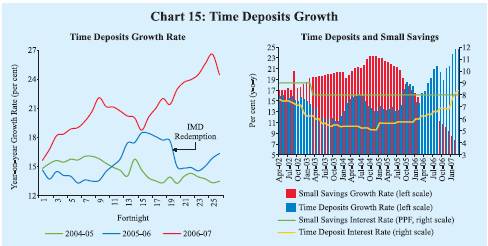
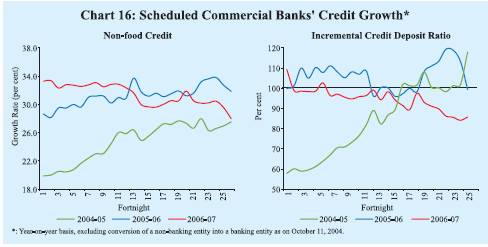
and ‘other retail loans’. Loans to commercial real estate, which increased by 66.7 per cent, y-o-y, absorbed 4.1 per cent of incremental non-food credit (Table 24). Against the backdrop of continuing high credit growth to the real estate sector, outstanding credit card receivables, loans and advances qualifying as capital market exposure and personal loans, the Reserve Bank in its Third Quarter Review (January 2007) raised provisioning requirements in respect of the standard assets in the aforesaid four categories of loans and advances (excluding residential housing loans) to two per cent from one per cent. The provisioning requirement for banks’ exposures in the standard assets category to the non-deposit taking systemically important non-banking financial companies (NBFCs) was raised to two per cent from 0.4 per cent; the risk weight for banks’ exposure to such NBFCs was also raised to 125 per cent from 100 per cent. In addition to bank credit for financing their requirements, the corporate sector continued to rely on a variety of non-bank sources of funds such as capital markets, external commercial borrowings and internal funds. Resources raised through domestic equity issuances during 2006-07 (Rs.28,595 crore) were more than double of those raised in 2005-06. Mobilisation through issuances of commercial papers during 2006-07 registered a turnaround, notwithstanding some sluggishness in the second half of the year. Resources raised through markets abroad – equity issuances (ADRs/GDRs) and external commercial borrowings –also increased substantially during 2006-07. While amounts raised through ADRs/ GDRs increased to Rs.16,184 crore during 2006-07 from Rs.7,263 crore a year ago, net disbursements under external commercial borrowings (ECBs) increased to Rs.48,328 crore during April-December 2006 from Rs.27,228 crore during April-December 2005. Finally, internal sources of funds continued to provide large financing support to the domestic corporate sector during the first three quarters of 2006-07. Profits after tax of select non-financial non-government companies during April- December 2006 were almost 43 per cent higher than the corresponding period of 2005 (Table 25).
Table 24: Deployment of Non-food Bank Credit |
(Amount in Rupees crore) |
Sector/Industry |
Outstanding
as on
December22, 2006 |
Year-on-year Variation |
December 23, 2005 |
December 22, 2006 |
Absolute |
Per cent |
Absolute |
Per cent |
1 |
2 |
3 |
4 |
5 |
6 |
Non-food Gross Bank Credit (1 to 4) |
16,23,653 |
2,83,487 |
33.3 |
3,84,785 |
31.1 |
1. |
Agriculture and Allied Activities |
1,97,763 |
41,771 |
39.6 |
46,991 |
31.2 |
2. |
Industry (Small, Medium and Large) |
6,25,309 |
86,215 |
25.0 |
1,35,929 |
27.8 |
|
Small Scale Industries |
1,00,599 |
12,717 |
18.7 |
18,822 |
23.0 |
3. |
Personal Loans |
4,27,909 |
n.a. |
n.a. |
1,10,613 |
34.9 |
|
Housing |
2,17,829 |
n.a. |
n.a. |
50,622 |
30.3 |
|
Advances against Fixed Deposits |
35,764 |
6.016 |
23.1 |
3,634 |
11.3 |
|
Credit Cards |
11,913 |
n.a. |
n.a. |
3,595 |
43.2 |
|
Education |
13,399 |
n.a. |
n.a. |
4,418 |
49.2 |
|
Consumer Durables |
8,558 |
-1,084 |
-13.5 |
1,615 |
23.3 |
4. |
Others |
3,72,672 |
n.a. |
n.a. |
91,252 |
32.4 |
|
Transport Operators |
22,610 |
n.a. |
n.a. |
10,598 |
88.2 |
|
Professional and Others |
19,379 |
n.a. |
n.a. |
6, 051 |
45.4 |
|
Trade |
99,194 |
n.a. |
n.a. |
23,139 |
33.9 |
|
Real Estate Loans |
39,642 |
14,201 |
155.4 |
15,859 |
66.7 |
|
Non-Banking Financial Companies |
38,150 |
10,111 |
59.4 |
7,456 |
24.3 |
|
|
|
|
|
|
|
Memo: |
|
|
|
|
|
|
|
|
|
|
|
|
Priority Sector |
5,64,396 |
1,28,773 |
41.7 |
1,12,782 |
25.0 |
Industry (Small, Medium and Large) |
6,25,309 |
86,215 |
25.0 |
1,35,929 |
27.8 |
Food Processing |
34,492 |
4,094 |
20.1 |
7,033 |
25.6 |
Textiles |
69,305 |
10,891 |
30.7 |
18, 274 |
35.8 |
Paper and Paper Products |
10,140 |
1,723 |
30.9 |
1,775 |
21.2 |
Petroleum, Coal Products and Nuclear Fuels |
31,021 |
2,962 |
20.6 |
12,441 |
67.0 |
Chemical and Chemical Products |
51,153 |
5,836 |
19.5 |
7,607 |
17.5 |
Rubber, Plastic and their Products |
7, 979 |
2,660 |
92.4 |
1,950 |
32.3 |
Iron and Steel |
58,896 |
10,391 |
38.2 |
14,877 |
33.8 |
Other Metal and Metal Products |
19,727 |
2,821 |
29.6 |
5,737 |
41.0 |
Engineering |
38,439 |
3,976 |
15.6 |
6,306 |
19.6 |
Vehicles, Vehicle Parts and Transport Equipments |
20,272 |
5,319 |
91.5 |
3,771 |
22.9 |
Gems and Jewellery |
21,795 |
4,572 |
42.3 |
3,613 |
19.9 |
Construction |
16,524 |
2,992 |
38.7 |
4,784 |
40.7 |
Infrastructure |
1,24,271 |
27,802 |
42.2 |
22,197 |
21.7 |
n.a. : Not available.
Note: 1. Data are provisional and relate to select scheduled commercial banks.
2. Owing to change in classification of sectors/industries and coverage of banks, data
for 2006 are not comparable with earlier data. |
Commercial banks’ investments in gilts increased by 10.0 per cent, y-o-y, as at end-March 2007 as against a decline of 2.7 per cent a year ago (Table 26). Growth in commercial banks’ investments in gilts was, however, substantially below the growth of 23.5 per cent in their net demand and time liabilities (NDTL). As a result, commercial banks’ holdings of Government securities declined to 28.0 per cent of their NDTL as at end-March 2007 from 31.3 per cent as at end-March 2006
(Chart 17). Excess SLR investments of SCBs fell to Rs.85,728 crore as at end-March 2007 from Rs.1,45,297 crore as at end-March 2006. Thus, apart from higher deposit growth, excess SLR investments continued to provide banks the flexibility to sustain strong demand for bank credit. Banks’ balances with the Reserve Bank expanded, reflecting the impact of the increase in their NDTL as well as the increase in the CRR.
Table 25: Select Sources of Funds to Industry |
(Rupees crore) |
Item |
2005-06 |
2006-07 |
2006-07 |
Q1 |
Q2 |
Q3 |
Q4 |
1 |
2 |
3 |
4 |
5 |
6 |
7 |
A. |
Bank Credit to Industry # |
1,27,192 |
74,981* |
-2,724 |
49,290 |
28,415 |
– |
|
|
|
|
(66,244)* |
|
|
|
|
|
B. |
Flow from Non-banks to Corporates |
|
|
|
|
|
|
|
1. Capital Issues (i+ii) |
13,781 |
29,180 |
10,627 |
1,882 |
10,840 |
5,831 |
|
|
i) |
Non-Government Public Ltd. |
|
|
|
|
|
|
|
|
|
Companies (a+b) |
13,408 |
29,180 |
10,627 |
1,882 |
10,840 |
5,831 |
|
|
|
a) Bonds/Debentures |
245 |
585 |
0 |
0 |
491 |
94 |
|
|
|
b) Shares |
13,163 |
28,595 |
10,627 |
1,882 |
10,349 |
5,737 |
|
|
ii) |
PSUs and Government Companies |
373 |
0 |
0 |
0 |
0 |
0 |
|
2. ADR/GDR Issues |
7,263 |
16,184 |
4,965 |
2,130 |
924 |
8,165 |
|
3. External Commercial
Borrowings (ECBs) |
45,078 |
48,328* |
20,503 |
13,651 |
14,174 |
– |
|
|
|
|
(27,228)* |
|
|
|
|
|
|
4. Issue of CPs |
-1,517 |
6,384@ |
6,931 |
4,795 |
-908 |
-4,434@ |
C. |
Depreciation Provision + |
28,883 |
24,557* |
8,449 |
8.892 |
9,172 |
– |
|
|
|
|
(22,044)* |
|
|
|
|
|
D. |
Profit after Tax + |
67,506 |
75,460* |
24,845 |
27,710 |
28,698 |
– |
|
|
|
|
(52,891)* |
|
|
|
|
|
#: Data pertain to select scheduled commercial banks. Figures for 2005-06 are not comparable
with those of 2006-07 due to increase in number of banks selected in the sample.
+: Data are based on audited/ unaudited abridged results of select sample of non-financial non-Government companies.
Quarterly variations may not add up to annual variation due to difference in coverage of companies.
*: Data pertain to April-December.
@ : Up to March 15, 2007.
Note: 1. Data are provisional.
2. Data on capital issues pertain to gross issuances excluding issues by banks and financial institutions. Figures are not adjusted for banks’ investments in capital issues, which are not expected to be significant.
3. Data on ADR/GDR issues exclude issuances by banks and financial institutions.
4. Data on ECBs include short-term credit. Data for 2005-06 are exclusive of the IMD redemption. |
Table 26: Scheduled Commercial Bank Survey |
(Amount in Rupees crore) |
Item |
Outstanding
as on
March 30, 2007 |
Variation (year-on-year) |
As on March 31, 2006 |
As on March 30, 2007 |
Amount |
Per cent |
Amount |
Per cent |
1 |
2 |
3 |
4 |
5 |
6 |
Sources of Funds |
|
|
|
|
|
1. |
Aggregate Deposits |
25,94,259 |
3,23,913 |
18.1 |
4,85,210 |
23.0 |
2. |
Call/Term Funding from FIs |
86,151 |
11,224 |
15.6 |
3,007 |
3.6 |
3. |
Overseas Foreign Currency Borrowings |
32,377 |
1,295 |
4.5 |
2,543 |
8.5 |
4. |
Capital |
33,868 |
5,705 |
21.2 |
1,254 |
3.8 |
5. |
Reserves |
1,66,290 |
34,616 |
31.3 |
21,177 |
14.6 |
Uses of Funds |
|
|
|
|
|
1. |
Bank Credit |
19,23,192 |
3,54,868 |
30.8 |
4,16,115 |
27.6 |
|
of which: Non-food Credit |
18,76,672 |
3,54,193 |
31.8 |
4,10,285 |
28.0 |
2. |
Investments in Government Papers |
7,71,060 |
-19,514 |
-2.7 |
70,318 |
10.0 |
3. |
Investments in Other Approved Securities |
21,100 |
-3,295 |
-16.5 |
4,388 |
26.3 |
4. |
Investments in Non-SLR Securities |
1,43,750 |
-11,838 |
-8.0 |
8,410 |
6.2 |
5. |
Foreign Currency Assets |
39,287 |
14,059 |
47.8 |
-4,207 |
-9.7 |
6. |
Balances with the RBI |
1,80,222 |
34,077 |
36.6 |
53,161 |
41.8 |
Note: Data are provisional. |
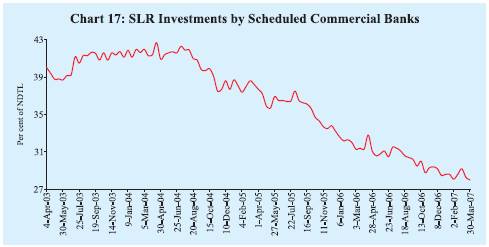
Reserve Money Survey
Reserve money expanded by 23.7 per cent, y-o-y, as on March 31, 2007 as compared with 17.2 per cent a year ago (Chart 18). Adjusted for the first round effects of the hikes in the CRR, reserve money growth (y-o-y) was 18.9 per cent as on March 31, 2007. 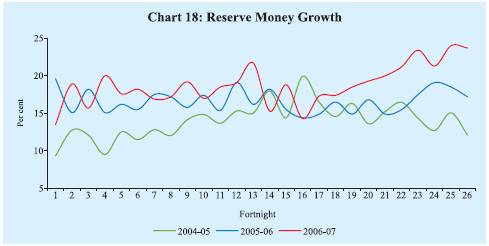
Growth in reserve money during 2006-07 was driven largely by the expansion in the Reserve Bank’s net foreign assets (NFA). The Reserve Bank’s foreign currency assets (net of revaluation) increased by Rs.1,64,601 crore during 2006-07 as compared with an increase of Rs.68,834 crore during the previous year (Table 27 and Chart 19). More than one-half of the increase in the Reserve Bank’s foreign currency assets (net of revaluation) during 2006-07 took place in the fourth quarter.
Table 27: Reserve Money |
(Rupees crore) |
|
Outstanding
as on
March 31, 2007 |
Variation during |
2005-06 |
2006-07 |
2006-07 |
Q1 |
Q2 |
Q3 |
Q4 |
1 |
2 |
3 |
4 |
5 |
6 |
7 |
8 |
Reserve Money |
|
7,08,950 |
83,922 |
1,35,892 |
13,470 |
18,666 |
14,210 |
89,546 |
(= 1+2+3 = 4+5+6+7-8) |
|
(17.2) |
(23.7) |
|
|
|
|
Components |
|
|
|
|
|
|
|
|
1. |
Currency in Circulation |
5,04,167 |
62,015 |
73,491 |
22,283 |
-2,011 |
26,871 |
26,348 |
|
|
|
|
(16.8) |
(17.1) |
|
|
|
|
2. |
Bankers’ Deposits with RBI |
1,97,295 |
21,515 |
61,784 |
-7,204 |
20,224 |
-12,165 |
60,929 |
|
|
|
|
(18.9) |
(45.6) |
|
|
|
|
3. |
‘Other’ Deposits with the RBI |
7,487 |
393 |
617 |
-1,610 |
453 |
-495 |
2,269 |
|
|
|
|
(6.1) |
(9.0) |
|
|
|
|
Sources |
|
|
|
|
|
|
|
|
4. |
RBI’s net credit to Government |
4,362 |
26,111 |
-3,775 |
53 |
2,826 |
-12,754 |
6,100 |
|
of which: to Centre (i+ii+iii+iv-v) |
4,118 |
28,417 |
-1,042 |
3,071 |
2,584 |
-12,568 |
5,871 |
|
i. Loans and Advances |
0 |
0 |
0 |
0 |
0 |
0 |
0 |
|
ii. Treasury Bills held by the RBI |
0 |
0 |
0 |
0 |
0 |
0 |
0 |
|
iii. RBI’s Holdings of Dated |
|
|
|
|
|
|
|
|
Securities |
|
97,172 |
13,869 |
26,763 |
-27,610 |
24,944 |
22,733 |
6,696 |
|
iv. RBI’s Holdings of Rupee coins |
12 |
7 |
-143 |
9 |
-107 |
97 |
-142 |
|
v. Central Government Deposits |
93,066 |
-14,541 |
27,662 |
-30,672 |
22,253 |
35,398 |
683 |
5. |
RBI’s credit to banks and |
|
|
|
|
|
|
|
|
commercial sector |
|
9,173 |
535 |
1990 |
-3,135 |
3,107 |
2,065 |
-47 |
6. |
NFEA of RBI |
|
8,66,153 |
60,193 |
1,93,170 |
71,845 |
11,392 |
27,250 |
82,682 |
|
|
|
|
(9.8) |
(28.7) |
|
|
|
|
|
of which : |
|
|
|
|
|
|
|
|
|
FCA, adjusted for revaluation |
– |
68,834 |
1,64,601 |
28,107 |
10,948 |
31,634 |
93,913 |
7. |
Governments’ Currency |
|
|
|
|
|
|
|
|
Liabilities to the Public |
8,229 |
1,306 |
-525 |
-920 |
155 |
166 |
75 |
8. |
Net Non-Monetary liabilities of RBI |
1,78,967 |
4,222 |
54,968 |
54,373 |
-1,186 |
2,517 |
-736 |
|
|
|
|
|
|
|
|
|
|
Memo: |
|
|
|
|
|
|
|
|
Net Domestic Assets |
|
-1,57,203 |
23729 |
-57277 |
-58,376 |
7,274 |
-13,040 |
6,864 |
Reserve Bank’s Primary Subscription |
|
|
|
|
|
|
|
to Dated Securities |
|
0 |
10,000 |
0 |
0 |
0 |
0 |
0 |
LAF, Repos (+) / Reverse Repos (-) |
29,185 |
12,080 |
36,435 |
-23,060 |
28,395 |
22,195 |
8,905 |
Net Open Market Sales # * |
– |
3,913 |
5,125 |
1,536 |
1,176 |
389 |
2,024 |
Mobilisation under MSS |
* |
62,974 |
-35,149 |
33,912 |
4,062 |
8,940 |
-3,315 |
24,225 |
Net Purchases(+)/Sales(-) from |
|
|
|
|
|
|
|
Authorised Dealers |
|
– |
32,884 |
1,07,347@ |
21,545 |
0 |
19,776 |
66,026@ |
NFEA/Reserve Money £ |
|
122.2 |
117.4 |
122.2 |
127.0 |
125.0 |
126.5 |
122.2 |
NFEA/Currency £ |
|
171.8 |
156.3 |
171.8 |
164.4 |
167.7 |
164.0 |
171.8 |
NFEA: Net Foreign Exchange Assets.
FCA : Foreign Currency Assets.
@: up to end-February 2007.
*: At face value.
# : Excludes Treasury Bills
£ : per cent, end of period.
Note: 1.Data are based on March 31 for Q4 and last reporting Friday for all other quarters.
2.Figures in parentheses are percentage variations during the fiscal year.
3.Government balances as on March 31, 2007 are before closure of accounts. |
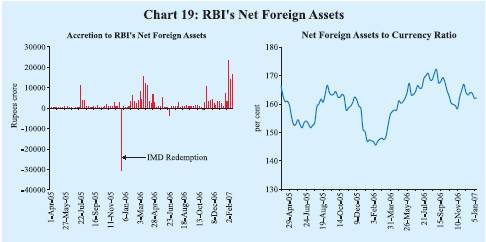
Mirroring the liquidity management operations, the Reserve Bank’s net credit to the Centre declined by Rs.1,042 crore in 2006-07 as against an increase of Rs.28,417 crore in the previous year. The decline in net RBI credit to the Centre during 2006-07 could be attributed mainly to an increase in balances under MSS (Rs.33,912 crore) and open market sales (Rs.5,125 crore), partly offset by increase in repo balances under LAF (Rs.36,435 crore).
Liquidity Management
During 2006-07, the Reserve Bank continued with its policy of active management of liquidity through open market operations (OMO) including MSS, LAF and CRR, and using all the policy instruments at its disposal flexibly. The liquidity management operations during the year were aimed at ensuring maintenance of appropriate liquidity in the system so that all legitimate requirements of credit, particularly for productive purposes, are met, consistent with the objective of price and financial stability. However, the task of liquidity management was complicated during 2006-07, with greater variation in market liquidity, largely reflecting variations in cash balances of the Governments and capital flows.
During the first quarter of 2006-07, unwinding of the Centre’s surplus balances with the Reserve Bank and the Reserve Bank’s purchase of foreign exchange from authorised dealers resulted in ample liquidity into the banking system. This was mirrored in an increase in the LAF reverse repo balances. Liquidity conditions continued to remain easy during the most part of the second quarter of 2006-07. Balances under the MSS also rose between May 2006 and September 2006, following the re-introduction of auctions under the MSS in May
2006. However, in view of some build-up of Government cash balances with the Reserve Bank during August-September 2006, there was a decline in balances under LAF reverse repos during the second quarter (Table 28).
Around mid-September 2006, liquidity conditions turned tight on account of advance tax outflows and festival season currency demand. The Reserve Bank, accordingly, injected liquidity through repos on eight occasions between mid-September 2006 and end-October 2006. However, there was net injection of liquidity only on two occasions (October 20 and October 23, 2006). Liquidity pressures eased by end-October 2006 following some decline in Government cash balances (Table 29). Liquidity conditions eased further during November 2006, partly reflecting purchases of foreign exchange by the Reserve Bank. Balances under LAF reverse repos started rising from the third week of November 2006, reaching Rs 34,255 crore as on December 6, 2006 (Chart 20).
Liquidity conditions, however, again turned tight from the second week of December 2006 largely due to advance tax outflows and announcement of increase in the CRR by 50 basis points. The Centre’s surplus with the Reserve Bank increased from Rs.31,305 crore at end-November 2006 to Rs.73,534 crore as on December 22, 2006. In view of the prevailing liquidity conditions, the Reserve Bank injected liquidity into the system through repo operations from December 13, 2006. Average daily net injection of liquidity by the Reserve Bank amounted to Rs.15,013 crore during December 13, 2006 in contrast to the average daily absorption of Rs.12,262 crore and Rs.9,937 crore during October and November 2006, respectively. Concomitantly, balances under the MSS declined during September-December 2006 in view of under-subscription in some of the auctions.
Although the Centre’s surplus declined during January 2007, liquidity conditions remained tight, partly reflecting the impact of the CRR hike. The Reserve Bank continued to inject liquidity through LAF operations during January 2007 (except for January 3-5, when there were net absorption of liquidity). Daily net injection of liquidity averaged Rs.10,738 crore during January 2007.
Table 28: Reserve Bank's Liquidity Management Operations |
(Rupees crore) |
Item |
2005-06 |
2006-07 |
2006-07 |
|
|
Q1 |
Q2 |
Q3 |
Q4 |
Jan. |
Feb. |
Mar. |
1 |
2 |
3 |
4 |
5 |
6 |
7 |
8 |
9 |
10 |
A. |
Drivers of Liquidity (1+2+3+4) |
-31,696 |
60,981 |
36,247 |
-16,683 |
-25,903 |
67,320 |
22,708 |
26,744 |
17,868 |
1. |
RBI’s Foreign Currency Assets |
|
|
|
|
|
|
|
|
|
|
(adjusted for revaluation) |
68,834 |
1,64,601 |
28,517 |
10,538 |
34,821 |
90,725 |
13,304 |
56,780 |
20,641 |
2. |
Currency with the Public |
-57,256 |
-71,052 |
-19,648 |
-1,058 |
-27,296 |
-23,050 |
-10,306 |
-10,283 |
-2,461 |
3. |
Surplus Cash balances of the Centre |
|
|
|
|
|
|
|
|
|
|
with the Reserve Bank |
-22,726 |
-1,164 |
40,207 |
-26,199 |
-30,761 |
15,590 |
23,088 |
-10,621 |
3,123 |
4. |
Others (residual) |
-20,547 |
-31,405 |
-12,828 |
36 |
-2,667 |
-15,945 |
-3,379 |
-9,131 |
-3,435 |
|
|
|
|
|
|
|
|
|
|
|
B. |
Management of Liquidity (5+6+7+8) |
57,969 |
-24,257 |
-39,003 |
32,026 |
31,625 |
-48,905 |
-29,051 |
-28,817 |
8,963 |
5. |
Liquidity impact of LAF Repos |
12,080 |
36,435 |
-35,315 |
40,650 |
33,600 |
-2,500 |
-20,240 |
-18,385 |
36,125 |
6. |
Liquidity impact of OMO (Net) * |
10,740 |
720 |
545 |
145 |
25 |
5 |
0 |
0 |
5 |
7. |
Liquidity impact of MSS |
35,149 |
-33,912 |
-4,232 |
-8,769 |
4,750 |
-25,660 |
-2,061 |
-3,432 |
-20,167 |
8. |
First round liquidity impact |
|
|
|
|
|
|
|
|
|
|
due to CRR change |
0 |
-27,500 |
0 |
0 |
-6,750 |
-20,750 |
-6,750 |
-7,000 |
-7,000 |
|
|
|
|
|
|
|
|
|
|
|
C. |
Bank Reserves (A+B) # |
26,273 |
36,724 |
-2,756 |
15,343 |
5,722 |
18,415 |
-6,343 |
-2,073 |
26,831 |
(+) : Indicates injection of liquidity into the banking system.
(-) : Indicates absorption of liquidity from the banking system.
# : Includes vault cash with banks and adjusted for first round liquidity impact due to CRR change.
* : Adjusted for Consolidated Sinking Funds (CSF) and Other Investments and including private placement.
Note : Data pertain to March 31 and last Friday for all other months. |
Table 29: Liquidity Management |
(Rupees crore) |
Outstanding as on
last Friday of |
LAF |
MSS |
Centre's Surplus
with the RBI @ |
Total (2 to 4) |
1 |
2 |
3 |
4 |
5 |
2005 |
|
|
|
|
March* |
19,330 |
64,211 |
26,102 |
1,09,643 |
April |
27,650 |
67,087 |
6,449 |
1,01,186 |
May |
33,120 |
69,016 |
7,974 |
1,10,110 |
June |
9,670 |
71,681 |
21,745 |
1,03,096 |
July |
18,895 |
68,765 |
16,093 |
1,03,753 |
August |
25,435 |
76,936 |
23,562 |
1,25,933 |
September |
24,505 |
67,328 |
34,073 |
1,25,906 |
October |
20,840 |
69,752 |
21,498 |
1,12,090 |
November |
3,685 |
64,332 |
33,302 |
1,01,319 |
December |
-27,755 |
46,112 |
45,855 |
64,212 |
2006 |
|
|
|
|
January |
-20,555 |
37,280 |
39,080 |
55,805 |
February |
-12,715 |
31,958 |
37,013 |
56,256 |
March* |
7,250 |
29,062 |
48,828 |
85,140 |
April |
47,805 |
24,276 |
5,611 |
77,692 |
May |
57,245 |
27,817 |
0 |
85,062 |
June |
42,565 |
33,295 |
8,621 |
84,481 |
July |
44,155 |
38,995 |
8,770 |
91,920 |
August |
23,985 |
42,364 |
26,791 |
93,140 |
September |
1,915 |
42,064 |
34,821 |
78,800 |
October |
12,270 |
40,091 |
25,868 |
78,229 |
November |
15,995 |
37,917 |
31,305 |
85,217 |
December |
-31,685 |
37,314 |
65,582 |
71,211 |
2007 |
|
|
|
|
January |
-11,445 |
39,375 |
42,494 |
70,424 |
February |
6,940 |
42,807 |
53,115 |
1,02,862 |
March* |
-29,185 |
62,974 |
49,992 |
83,781 |
@ : Excludes minimum cash balances with the Reserve Bank.
* : Data pertain to March 31.
Note : Negative sign in column 2 indicates injection of liquidity through LAF repo. |
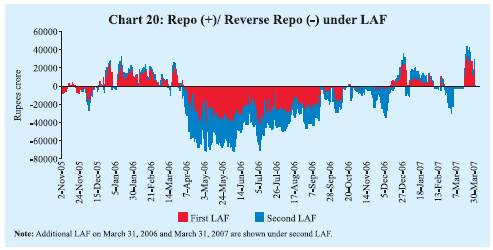
Liquidity conditions eased from the second week of February 2007, partly reflecting the purchases of foreign exchange from authorised dealers. LAF window witnessed net absorption of liquidity during February 8 - March 4, 2007 (except during February 15-20, 2007). Taking into account, inter alia, the liquidity conditions, the Reserve Bank, on February 13, 2007, announced another increase of 50 basis points in the CRR – 25 basis points each – effective in the fortnights beginning February 17, 2007 and March 3, 2007. Furthermore, on a review of the liquidity conditions, the Reserve Bank on March 2, 2007 announced modifications in liquidity management operations. An enhanced MSS programme was put in place to restore LAF as a facility for equilibrating very short-term mismatches and modulating the liquidity it absorbs through the daily reverse repo auctions. It was decided to use a mix of Treasury Bills and dated securities for MSS issuances in a more flexible manner keeping in view the capital flows in the recent period, the assessment of volatility and durability of capital flows, and the paramount importance attached to liquidity management in containing inflation. Concomitantly, beginning March 5, 2007, daily reverse repo absorptions were restricted to a maximum of Rs.3,000 crore comprising Rs.2,000 crore in the First LAF and Rs.1,000 crore in the Second LAF. Reflecting the modified arrangements, the balances under the LAF remained at around Rs.3,000 crore during March 5-15, 2007 while those under the MSS increased from Rs.42,807 crore at end-February 2007 to Rs.62,974 crore by March 31, 2007.
Liquidity conditions tightened from March 16, 2007 in view of advance tax outflows, the concomitant increase in the Centre’s surplus from Rs.36,476 crore as on March 9, 2007 to Rs.77,006 crore as on March 23, 2007 and the effect of the CRR hike. Accordingly, the Reserve Bank injected liquidity through repo operations, averaging Rs.31,254 crore during March 16-30, 2007. On March 21, 2007, the Reserve Bank clarified that the recourse to LAF by market participants should not be persistent in order to fund balance sheets for credit needs of customers, but banks could utilise the funds borrowed under this facility for inter-bank lending. Such inter-bank lending is part of normal money market functioning and enables daily liquidity management by market participants with temporary mismatches. At the request of the market participants, the Reserve Bank conducted an additional LAF auction between 3.30 PM and 4.00 PM on March 31, 2007.
Liquidity conditions eased in early April 2007, partly on account of the reduction in the Centre's surplus. Balances under LAF repos, net of reverse repos, fell from Rs.29,185 crore as on March 31, 2007 to Rs.1,455 crore as on April 8, 2007. During April 9-15, 2007, there was net absorption of liquidity. Absorptions under the reverse repo remained limited to a maximum of Rs.3,000 crore in accordance with the modified arrangements. There was again net injection of liquidity during April 16-18, 2007, averaging Rs.16,988 crore daily. |






























